







 10 Sep 2024
10 Sep 2024
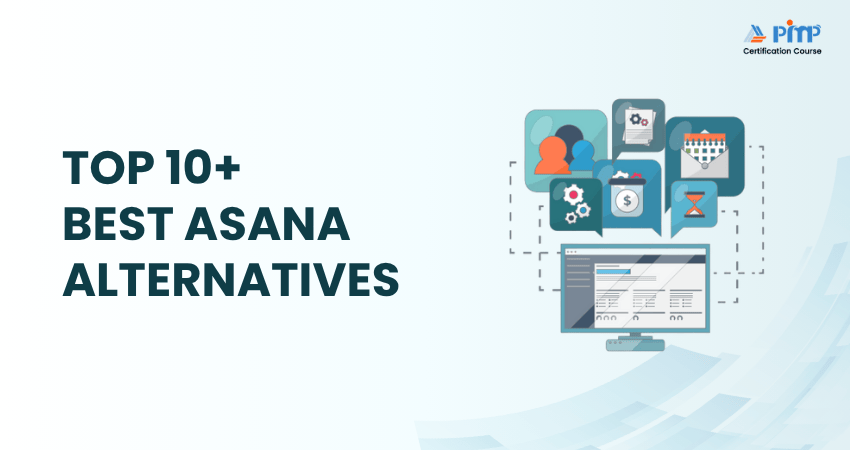


Asana is good for sure as it helps you survive your to-do list. But you’re not here to just check boxes, you’re here to crush goals. These 10+ Asana Alternatives offer features that fit your workflow and what your team deserves.
This blog cuts through the noise and delivers these alternatives. With standout features, fair pricing, and an edge Asana can’t match, they’re not here to compete, they’re here to win. Let’s dive in!
Table of Contents
1) Why Consider Alternatives to Asana?
2) Top Asana Alternatives for Project Management
3) ClickUp
4) Monday.com
5) Wrike
6) Airtable
7) Trello
8) Smartsheet
9) Jira
10) Basecamp
11) Notion
12) Teamwork
13) ProofHub
14) Choosing the Best Asana Alternative for Your Team’s Needs
15) Conclusion
Asana is a well-known Project Management tool, but it’s not a one-size-fits-all solution. Many teams eventually find that Asana doesn’t fully meet their evolving needs. Here are some common reasons why businesses and teams consider switching:
1) Limited Customization: Asana’s structure works well for basic Task Management, but it can be restrictive when trying to build complex workflows.
2) Missing Built-in Features: Essential features like native time tracking, advanced reporting, and Gantt charts aren’t available unless you use third-party integrations.
3) Price Increases with Team Size: As your team grows, so does the cost. For large teams or those scaling quickly, Asana’s pricing can become less budget-friendly compared to alternatives.
4) Steep Learning Curve for Some Users: While Asana has a clean interface, new users, especially those who are unfamiliar with digital Project Management tools.
5) Better Options for Specific Use Cases: Some tools are better suited for Software Development, content planning, client work, or data-heavy projects, offering features that Asana lacks.
If Asana isn’t ticking all the boxes for your team, fortunately, there are plenty of powerful tools out there that offer more flexibility, better features, or simpler interfaces. Let’s take a look at the top Asana Alternatives to help you manage projects with ease and confidence in 2025.
ClickUp is an all-in-one Project Management powerhouse designed for flexibility and collaboration. It offers over 15 customizable views like List, Board, Gantt, Calendar, Workload, Mind Map. Let’s discuss with details for better choosing:
Here are the key features:
1) ClickUp Docs for real‑time collaboration on SOPs, wikis, and meeting notes.
2) Whiteboards for brainstorming and visual mapping.
3) Powerful automations and templates, from task dependencies to recurring workflows.
4) Custom task statuses and fields to match your team’s exact process.
5) Goal tracking (OKRs) to align work with team objectives ClickUp.
6) AI-powered assistant “ClickUp Brain”, which automates routine tasks, summarizes. threads, drafts updates, and pulls contextual info from tasks and docs.
7) Native integrations with Slack, Google Calendar, GitHub, Teams, and over 1,000 Zapier apps.
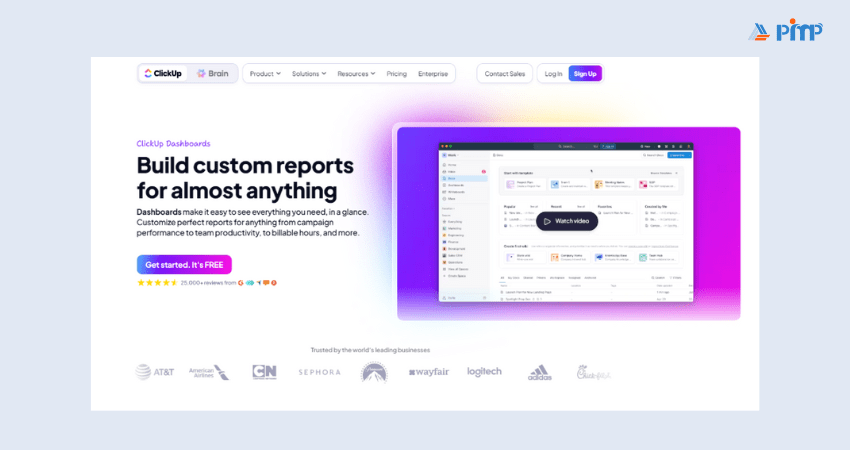
1) No paywalls, many advanced features are available even on the free plan.
2) Highly customizable for agencies, dev teams, and operations.
3) AI features (Brain) save hours, summaries, task suggestions, status nudges all automated.
4) Multiple assignees per task, thread‑assigned comments, and status flexibility.
5) Centralized communication like tasks, docs, emails, comments all tied together.
1) Can feel overwhelming for new or non-technical users, especially small teams
2) Mobile apps lack full feature parity with desktop version
ClickUp offers flexible pricing plans to suit teams of all sizes and needs. Whether you’re a small startup or a large enterprise, ClickUp’s tiered pricing structure allows you to select the right features and capabilities for your workflow. Below is a breakdown of the available pricing options:
1) Free Plan
a) Price: $0
b) Key Features: Unlimited tasks, 60 MB storage, unlimited members.
2) Unlimited
a) Price: $7/user/month (billed annually)
b) Key Features: Unlimited storage, integrations, and dashboards.
3) Business
a) Price: $12/user/month (~$19 billed monthly)
b) Key Features: Google SSO, unlimited teams, advanced automations.
4) Enterprise
a) Price: Custom pricing
b) Key Features: White-labelling, conditional form logic, advanced privacy controls.
5) ClickUp Brain (AI Add-On)
a) Price: $7/user/month (add-on to any paid plan)
b) Key Features: AI assistant for task automation, summaries, and smart suggestions.
Get hands-on training in Project Management Software – Start with the Slack Certification now!
Looking for a Project Management tool that’s colorful, visual, and easy for your whole team to use. Monday.com has become a favorite across creative, marketing, and operations teams. Let’s explore what makes it stand out.
Monday.com is packed with features designed to make managing projects feel less like admin and more like action. Some of its most useful features include:
1) Multiple views like Kanban, Calendar, Gantt, Timeline, and Workload.
2) Drag-and-drop functionality for quick updates and customization.
3) Custom dashboards with widgets for tracking time, budgets, and progress.
4) In-built automation and forms to reduce manual tasks.
5) Seamless integrations with tools like Slack, HubSpot, Teams, and Salesforce.
6) Robust compliance with GDPR, SOC 2, and ISO/IEC 27001.
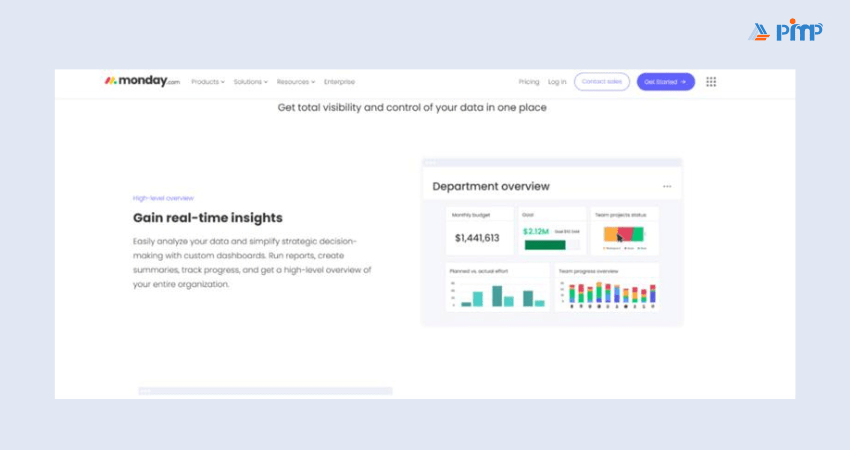
Now let’s talk about what Monday.com does really well. Here’s why so many teams prefer it over Asana:
1) User-friendly interface with bright visuals that simplify onboarding
2) Flexible dashboards and layouts to match different workflows
3) Excellent Data Visualization and reporting tools
4) More cost-effective than Asana for similar feature sets
5) Helpful onboarding and responsive customer support
No tool is perfect, and Monday.com has a few drawbacks to consider:
1) Free version is limited to two users and three boards
2) Automation setup can be tricky for beginners
3) Larger or more complex boards may load slowly over time
Monday.com offers a pricing structure that scales with your team’s needs. Here’s a breakdown of its core plans (prices in USD, GBP equivalents may vary):
1) Free
a) Price: $0 (2 users max)
b) Key Features: Three boards, basic columns, limited features
2) Basic
a) Price: $9/user/month
b) Key Features: Unlimited boards, basic integrations, 5 GB storage, 24/7 support.
3) Standard
a) Price: $12/user/month
b) Key Features: Timeline/calendar views, 250 automations/month, dashboards, guest access.
4) Pro
a) $19/user/month
b) Key Features: Time tracking, advanced dashboards, 25,000 automations/month, private boards.
5) Enterprise
Price: Custom pricing
Key Features: Enterprise security, 24/7 premium support, advanced permissions & controls.
Wrike is a strong alternative to Asana as it’s built with flexibility, customization, and enterprise-grade features in mind. These features make it useful for agencies, IT teams, and larger organizations.
Wrike is built to support dynamic teams and multi-layered workflows. Its standout features include:
1) Gantt charts with task dependencies and milestones for precise scheduling.
2) Custom request forms to streamline project intake and approvals.
3) Workload and Resource Management for better team capacity planning.
4) Advanced dashboards and reports for real-time analytics.
5) Extensive integrations with over 400 tools including Salesforce, Adobe Creative Cloud, Slack, and Gmail.
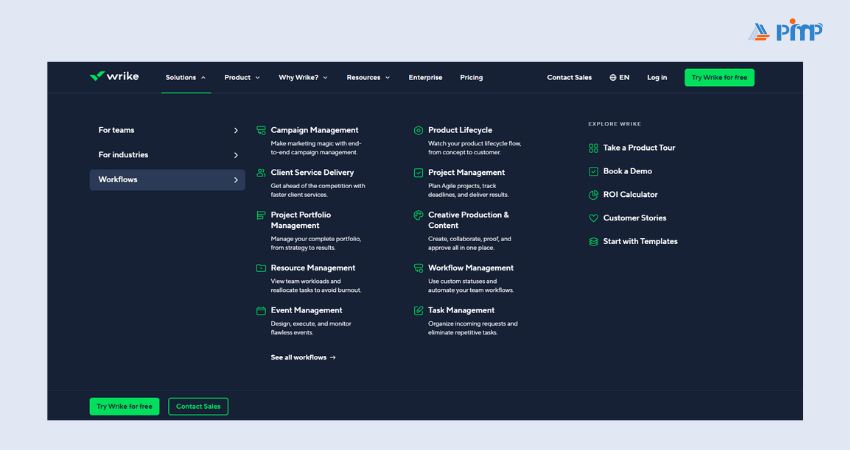
Here’s why many enterprise teams and marketing agencies prefer Wrike:
1) Great for managing multiple complex projects across departments
2) Built-in resource planning and time tracking make workload allocation simple
3) Strong customization with dashboards, forms, workflows, and access levels
4) Enhanced security controls, ideal for organizations with strict data policies
Despite its strengths, Wrike may not suit everyone. Consider the following:
1) The user interface can feel less intuitive compared to newer tools like ClickUp or Monday.com.
2) Annual billing only, which may not suit startups needing monthly flexibility.
3) Team plan caps at 15 users, which can be limiting for growing businesses.
Wrike’s pricing is tiered based on features and team size. Below is a breakdown of their core plans:
1) Free
a) Price: $0
b) Key Features: Basic Task Management with Kanban and table views; up to 2 GB storage per account; unlimited users.
2) Basic
a) Price: $9.80/user/month (billed annually, 2–15 users)
b) Key Features: Includes Gantt charts, dashboards, custom fields, 50 automations/user/month.
3) Standard
a) Price: $24.80/user/month (5–200 users)
b) Key Features: Adds time tracking, advanced reporting, Resource Management, project blueprints.
4) Pro
a) Price: Custom pricing
b) Key Features: Includes SSO, admin controls, audit logs, 1,000 automations/user/month.
5) Enterprise
a) Price: Custom pricing
b) Key Features: Offers full analytics, budgeting tools, job roles, and up to 1,500 automations/user/month.
Simplify Project Management with Wrike Training – Register today to learn from Experts!
Airtable is a great option as it blends database power with a clean, modern interface, perfect for content teams, marketers, and planners who want flexibility without diving into code. Let’s explore what makes Airtable stand out as a one of the Asana Alternatives.
Airtable is built for structure, creativity, and collaboration. Its features combine spreadsheet-style input with the logic of databases and powerful visual tools:
1) Multiple views like Grid, Kanban, Calendar, Timeline, Gantt.
2) Relational database linking between tables.
3) Interface Designer for building custom, no-code dashboards.
4) Automation and scripting to reduce repetitive work.
5) tools like Omni and Agents for smarter workflows.
6) Integrates with popular apps including Slack, Gmail, and Google Calendar.
Airtable brings a lot to the table, pun intended. Here’s what users love about it:
1) Combines spreadsheet ease with database power.
2) Great for content calendars, CRMs, product tracking, and editorial workflows.
3) Automation saves time and keeps data flowing.
4) Clean, user-friendly interface that's easy to adopt.
5) AI features enhance productivity and streamline setup.
It’s not all perfect, especially if you’re scaling fast. Consider these limitations:
1) Higher pricing for premium views like Gantt and AI credits.
2) Limits on records and automation in lower plans.
3) Some learning curves for advanced features like scripting or interface building.
Airtable’s plans range from free for small teams to enterprise-level for big operations.
1) Free
a) Price: $0
b) Key Features: 1,000 records/base, 5 editors, 100 automations, 1 GB storage.
2) Team
a) Price: $20/user/month
b) Key Features: Gantt/timeline views, 50,000 records, 25,000 automations, 20 GB storage.
3) Business
a) Price: $45/user/month
b) Key Features: Premium sync, admin tools, 125,000 records, 100 GB storage.
4) Enterprise
a) Price: Custom
b) Key Features: 500,000 records, 500,000 automations, 1 TB storage, governance tools.
Build custom workflows and automate tasks with Airtable Training - Start your journey today!
Trello is a top pick and with its intuitive Kanban board layout and minimal setup, it's ideal for individuals, freelancers, or small teams who want quick, hassle-free tracking without complexity.
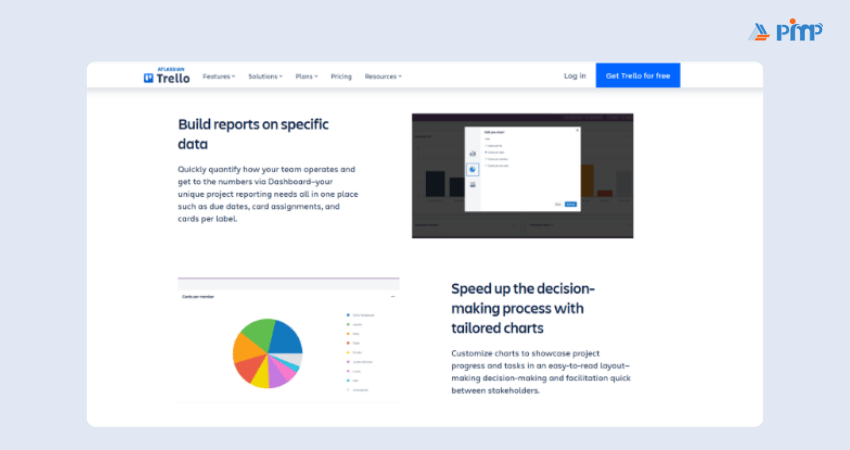
Trello delivers core task management with a clean, drag-and-drop interface and useful add-ons:
1) Visual Kanban boards, lists, and cards for easy workflow setup smartworking.
2) Cards with checklists, labels, due dates, file attachments, and commenting.
3) Butler automation for simple recurring actions.
4) “Power-Ups” to add features like Calendar view, integrations, custom fields Trello.
5) New AI-powered inbox and planner features (beta April 2025) for capturing tasks from Slack, email, Siri the Verge.
6) Seamless integration with Google Drive, Slack, Dropbox, Jira, and more.
Trello’s strengths lie in its simplicity and affordability:
1) Extremely easy to use, ideal for teams onboarding quickly.
2) Generous free plan, unlimited cards, 10 boards, one Power-Up per board, 10 MB file uploads.
3) Cost-effective paid plans starting from just $5/user/month.
4) Automations and Power-Ups expand functionality affordably.
Trello may be too basic for teams needing advanced features:
1) Core features like dependency tracking, Gantt charts, and portfolio management require paid add-ons or Power-Ups.
2) Not ideal for managing complex or multi-project environments.
3) Limited admin tools and reporting capabilities unless on Premium or Enterprise plans.
Trello offers flexible plans depending on scale and needs (USD pricing; GBP varies):
1) Free
a) Price: $0
b) Key Features: 10 boards, 1 Power-Up/board, 10 MB uploads.
2) Standard
a) Price: $5/user/month
b) Key Features: Unlimited boards, custom fields, 250 MB attachments.
3) Premium
a) Price: $10/user/month
b) Key Features: Timeline, calendar, dashboard views, unlimited automation.
4) Enterprise
a) Price: From $17.50/user/month
b) Key Features: Org-wide admin controls, SSO, unlimited Power-Ups.
Manage projects with full potential and ease – Get insights from the Trello Training with simple steps!
Smartsheet offers potent capabilities for organizations that value structure, reporting, and cross-team alignment. It is popular in industries like operations, healthcare, marketing, or regulated environments.
Smartsheet merges spreadsheet familiarity with advanced project tools, such as:
1) Spreadsheet-like "sheets" with rows, rich formulas, dependencies, and attachments.
2) Multiple views grid, Gantt, calendar, board, plus dashboards with interactive widgets.
3) Workload tracking and resource management heat maps.
4) Automation and request forms, including approval flows and alerts.
5) Collaboration tools for internal and external stakeholders with flexible sharing and proofing options.
6) Strong integration ecosystem: Microsoft 365, Google Workspace, Salesforce, Adobe, and more.
Here’s what users commonly praise:
1) Combines Excel-like usability with Project Management depth.
2) Excellent real-time dashboards and reporting, praised in large organizations such as GSK and Palfinger.
3) Scalable collaboration, including guest access and secure external editing.
4) High customer satisfaction and usability scores across verified reviewers.
Potential drawbacks to be aware of:
1) No long-term free plan, only a 30-day trial before paid tiers are required.
2) Steep learning curve for non-spreadsheet users; advanced setups benefit from training like Smartsheet University.
3) Can feel basic or rigid compared to modern PM tools; complex customizations may require more admin overhead.
Here’s a streamlined distillation of Smartsheet’s public pricing as of mid‑2025 (USD; GBP rates vary).
1) Pro
a) Price: $9/user/month
b) Key Features: Multiple views, 250 automations/month.
2) Business
a) Price: $19/user/month
b) Key Features: Advanced reports, proofing, resource tracking.
3) Enterprise
a) Price: Custom pricing
b) Key Features: Governance, SSO, unlimited sheets.
4) Advanced WM
a) Price: Custom pricing
b) Key Features: WorkApps, portfolio control, AI insights.
Trusted by tech teams globally, Jira is the go‑to alternative to Asana. It’s built to handle complex development pipelines and structured delivery in a scalable way.
Jira is geared toward technical teams and agile methodology:
1) Full issue and bug tracking with Scrum and Kanban boards.
2) Agile planning tools such as backlogs, sprints, roadmaps, and burndown charts.
3) Extensive automation capabilities and customizable workflows.
4) Views including list, board, timeline, roadmap, and reports.
5) Deep integration with developer tools like Git, CI/CD, Confluence, etc.
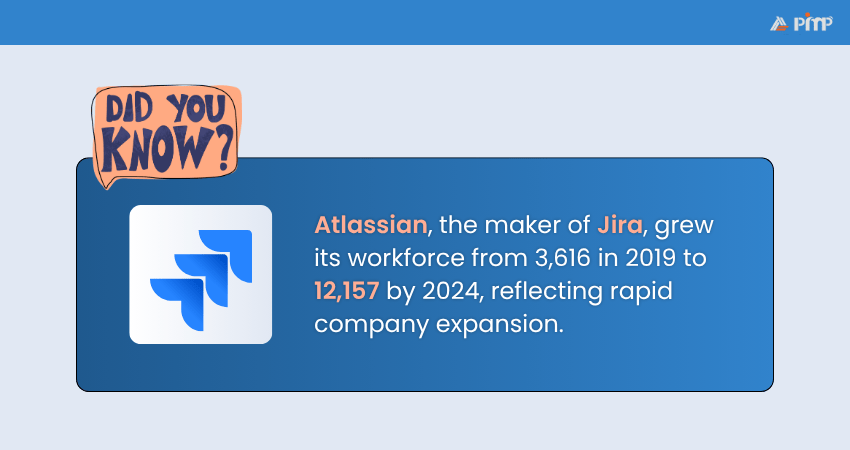
Why many development-led teams prefer Jira:
1) Excellent for managing software projects using Agile frameworks.
2) Powerful automation, reporting, and metrics tailored to developers.
3) Large ecosystem with thousands of integrations and add-ons.
4) Solid value offers robust functionality at competitive pricing.
Things to consider before choosing Jira:
1) Steep learning curve, especially for non-technical users.
2) Interface often feels clunky or less intuitive than tools like Asana.
3) Setup and administration require more effort and structure.
Here’s a simplified view of Jira Software’s cloud pricing (USD, annual billing; GBP varies)
1) Free
a) Price: $0 (up to 10 users).
b) Key Features: Scrum/Kanban boards, basic views, 100 automations, 2 GB storage.
2) Standard
a) Price: $8.60/user/month.
b) Key Features: Jira roles & permissions, 1,700 automations/month, 250 GB storage.
3) Premium
a) Price: $17/user/month.
b) Key Features: Unlimited storage, advanced roadmaps, AI tools, 24/7 support.
4) Enterprise
a) Price: Custom pricing.
b) Key Features: Multi-instance support, enterprise‑grade security & governance.
Basecamp might be the fit for small to mid-sized teams focused on communication rather than complex task workflows.
Basecamp emphasizes simple, effective team collaboration and basic project tracking tools:
1) Message boards, to‑do lists, automatic check‑ins, and Campfire group chat.
2) Card Table (basic Kanban view) and Hill Charts for high-level progress tracking.
3) Schedules, docs & files storage, and client access management.
Basecamp’s standout strengths make it ideal for certain team setups:
1) Super user‑friendly and fast to onboard, even for non‑tech users.
2) Communication tools are centralized, reducing reliance on Slack or email.
3) Simple permission settings and client sharing built-in.
4) Flat-rate pricing model scales well for large teams.
This platform has some limitations to keep in mind:
1) No built-in time tracking, Gantt charts, task dependencies, or advanced dashboards.
2) Lacks strong workflow customization or automation capabilities.
3) Interface may feel outdated and less intuitive than modern tools.
Basecamp keeps pricing refreshingly simple with just two options that are easy for teams to scale without worrying about per-user costs. Here’s a quick look:
1) Basecamp (Per User Plan)
a) Price: $15/user/month (monthly billing).
b) Key Features: Access to core features, 500 GB storage, guest access, month-to-month flexibility.
2) Pro Unlimited
a) Price: $299/month (annual) or $349/month (monthly).
b) Key Features: Unlimited users, 5 TB storage, 1:1 onboarding, advanced admin tools and timesheets.
Get hands-on Basecamp Training to improve your team’s collaboration skills – Register today!
Notion is ideal for teams or individuals who value structure without sacrificing creativity in startups, content teams, or internal knowledge-sharing use cases.
Notion offers a modular workspace where everything is built from content blocks, making it easy to customize:
1) Pages built from blocks supporting Kanban, table, calendar, gallery views, and databases.
2) Powerful relational databases with custom views and filtering.
3) Customizable Automations, Forms, and Layouts for team workflows.
4) Notion AI for content generation, summarization, workspace search, and database autofill.
5) Deep integration with tools like Slack, GitHub, Zoom, Google Drive via API and templates.

What makes Notion stand out for many teams:
1) Extremely flexible, can serve as notes, tasks, docs, or even lightweight project hubs.
2) Clean UI, easy to customize, and ideal for internal knowledge bases Efficient App.
3) Affordable Free plan with generous features for individual users or small teams.
4) Notion AI enhances productivity, especially for content creators and planners on paid tiers.
Some challenges to bear in mind:
1) It can be overwhelming if structured flexibility leads to decision fatigue for teams.
2) Mobile and offline support lag desktop, especially for heavy database users.
3) AI now reserved for Business & Enterprise users; free/Plus have limited or trial access.
Notion’s pricing changed recently, shifting AI access to higher tiers. Here’s the current structure.
1) Free
a) Price: $0/user/month (annual billing).
b) Key Features: Basic pages & blocks, limited to 5 MB file uploads, 7-day version history, up to 10 guests.
2) Plus
a) Price: $10/user/month.
b) Key Features: Unlimited content blocks, 30-day version history, up to 100 guests, no file size. restrictions
3) Business
a) Price: $20/user/month.
b) Key Features: Private teamspaces, advanced permissions, 90-day version history, Notion AI access.
4) Enterprise
a) Price: Custom pricing.
b) Key Features: Enterprise governance, audit logs, Single Sign-On (SSO), workspace consolidation.
Simplify project planning with our easy and practical Notion Training - Sign up today!
For agencies, consultancies, or service-oriented teams managing client projects and billing, teamwork stands out as a highly effective and feature-rich alternative to Asana. It brings together Task Management, time tracking, reporting, and client communication within one platform.
Teamwork offers tools tailored for client-focused teams, including:
1) Project views like Kanban boards, Gantt charts, timelines, and dashboards.
2) Built-in time tracking and timesheets with billable rates.
3) Client Management tools, invoicing, budgeting, client dashboards, and proofing workflows.
4) Automations, request forms, and custom workflows.
5) Reporting tools for workload, profitability, and resource planning Teamwork.
6) Chat, notebook, and collaboration features integrated into the platform.
Here's what makes Teamwork appealing for client-facing teams:
1) Strong support for client-centric workflows, including invoices and proofs.
2) Excellent workload/resource management and time tracking built-in.
3) Competitive pricing, more features at lower cost than Asana’s equivalent plans.
4) Easy for teams to collaborate, with an intuitive interface and flexible project setup.
Notable limitations to consider:
1) Interface and navigation can be less streamlined than newer tools.
2) Learning curve due to breadth of features, especially for smaller teams or those new to project.
3) Free plan limited to five users and only two active projects at a time.
Teamwork offers both a generous free tier and scalable paid plans, ideal for service teams of all sizes.
1) Free
a) Price: $0/user/month (up to 5 users, 2 projects).
b) Key Features: Time tracking, invoicing, Gantt/Kanban views, basic reporting.
2) Deliver
a) Price: $10.99/user/month (annual billing).
b) Key Features: Unlimited users, client management tools, budgeting, Gantt charts.
3) Grow
a) Price: $19.99/user/month (annual billing).
b) Key Features: Advanced workflows, proofing, Resource Management, comprehensive reporting.
4) Scale
a) Price: $54.99/user/month (annual billing).
b) Key Features: Unlimited access, enterprise-grade features, high-security support.
5) Enterprise
a) Price: Custom pricing.
b) Key Features: Dedicated support, SSO, custom infrastructure, SLAs, and governance.
ProofHub is worth considering as it is useful for teams managing client projects, design workflows, or large groups where collaboration and cost-efficiency are key.
ProofHub offers a comprehensive suite for both team collaboration and structured project delivery:
1) Task lists, Gantt charts, Kanban boards, and calendar views.
2) Subtasks, priorities, deadlines, and dependencies.
3) Built-in time tracking and basic timesheets.
4) Team chat, announcements, discussions, and notes.
5) File proofing and version control for creative feedback.
6) Request forms, custom workflows, roles, and templates.
7) Activity logs, reports, and integrations with cloud storage apps and APIs.
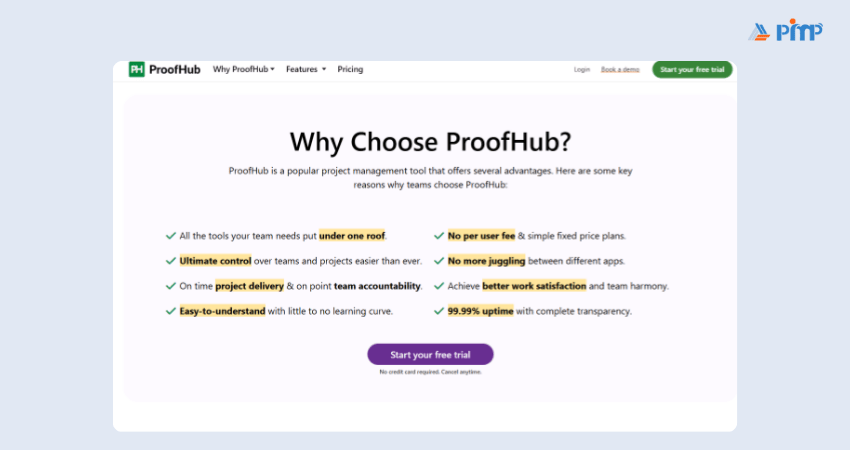
ProofHub stands out for its practical value and team-friendly features:
1) Flat pricing, unlimited users and projects without extra cost.
2) Integrated communication and collaboration tools in one platform.
3) Easy to set up and use, even for less technical teams .
4) Built-in time tracking, proofing, and task dependencies keep teams on track.
There are trade-offs to consider:
1) Interface can feel cluttered and less modern than competitors.
2) Time tracking and integrations are functional but basic.
3) Workflow automation and customization are less flexible than in premium tools like ClickUp.
ProofHub charges a flat monthly rate for unlimited users and projects.
1) Essential
a) Price: $45/month (annual) or $50/month.
b) Key Features: 40 projects, 15 GB storage, basic PM tools.
2) Ultimate Control
a) Price: $89/month (discounted annual) or $99/month.
b) Key Features: Unlimited projects/users, 100 GB storage, custom roles, workflows, priority support.
With so many excellent Asana Alternatives available, the right choice depends on your team's size, workflow complexity, and collaboration style. Here’s how to decide:
1) For all-in-one Functionality: Go with ClickUp. It’s packed with features and suits everything from startups to enterprise teams.
2) For Visual Simplicity and ease of use: Monday.com or Trello are perfect for non-technical teams that love drag-and-drop workflows.
3) For Agile or development Teams: Jira is purpose-built for software projects, with issue tracking, sprints, and roadmap planning.
4) For Client-facing Businesses: Teamwork or Basecamp offer built-in client tools, invoicing, and a collaborative workspace.
5) For Spreadsheet-style Control: Smartsheet blends the power of Excel with project tracking features, great for operations and planning.
6) For Database and Content Planning: Airtable and Notion offer customisable, flexible platforms for editorial, CRM, or internal tools.
7) For design and Feedback Workflows: ProofHub delivers flat-rate pricing, proofing tools, and structured collaboration.
Finding the right Asana Alternatives depends on your team’s size, goals, and workflow style. Whether you need advanced features, budget-friendly plans, or visual simplicity, there’s a perfect match out there. Explore your options, try a few, and choose the one that best supports your team’s productivity, collaboration, and long-term project success. The right tool makes all the difference.
Learn to lead projects with the right tools – Join our Project Management Tools Courses today!






© Copyright 2025. All rights reserved. Contact: PMP® TRAINING ACADEMY.


